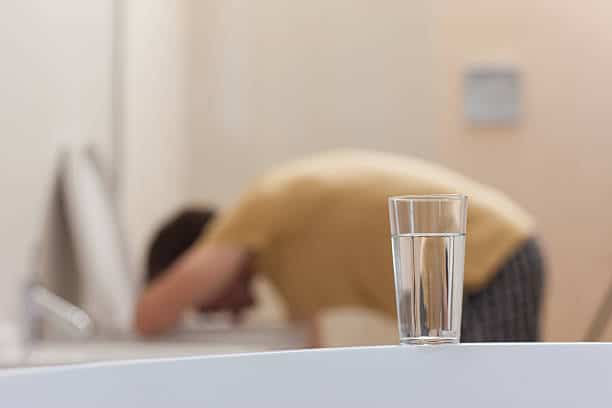It’s never fun to throw up, but occasionally your body needs to get rid of harmful substances. If you drink enough alcohol to reach a hazardous level in your bloodstream, you may experience nausea and vomiting. You throw up because your body is trying to get rid of the poison before it can cause permanent damage to your brain or other organs.
Table Of Contents
−Common reasons why adults vomit
Any of the following might cause an adult vomiting:

Gastroenteritis
If you’ve been throwing up, you likely have gastroenteritis. One of the most prevalent reasons why grownups throw up is this. It usually is accompanied by diarrhea. It’s brought on by eating tainted food or contracting a virus from someone sick, such as norovirus. It can also be due to food poisoning. After a few days, your immune system should be able to clear out the infection.
Pregnancy
Even though it can happen at any time, this is commonly referred to as “morning sickness.” Morning sickness is a common pregnancy symptom that often begins in the first trimester and subsides between weeks 16 and 20. It is common for pregnant women, especially in the first trimester, to undergo frequent bouts of nausea and vomiting.
Appendicitis
Appendicitis is a common condition that necessitates surgical removal of the appendix. There may be a lot of discomfort in the belly when you have appendicitis. If your abdominal pain worsens rapidly and extends throughout your body, you should call an ambulance immediately.
Labyrinthitis
Your vertigo and dizziness may be symptoms of labyrinthitis, an inner ear infection. In most cases, labyrinthitis clears up after a few days, and if it doesn’t, your doctor can prescribe medicine to alleviate your symptoms.
Migraines
Migraines can be diagnosed if one experiences frequent bouts of vomiting in addition to severe, throbbing headaches that range in duration from a few hours to several days. Traditional pain relievers like paracetamol and ibuprofen can sometimes help, and your doctor can prescribe anti-nausea medication if you need it to keep from throwing up.
Motion sickness
It’s possible that your travel sickness symptoms, such as nausea and vomiting, are due to motion sickness. Although medications to prevent and treat motion sickness are available, strategies like keeping your eyes on the horizon or listening to music can often help alleviate these sensations.
Other triggers of vomiting
Many medical conditions and treatments, such as chemotherapy, radiotherapy, kidney infections, and kidney stones, can trigger adult vomiting. Stones or infections in the kidney can also cause it.
Another reason could be gallstones or hernias that cause blockage in the bowel. It can also be attributed to gallbladder inflammation. Lastly, too much alcohol consumption or taking prescriptions such as certain painkillers and antibiotics may trigger vomiting in adults.
How to prevent throwing up

Preventing vomiting is achievable in cases of nausea caused by motion sickness, pregnancy, or stress.
If you’re looking for some advice, try these:
- Inhale fresh air
- Do deep breaths
- Do not do physical activities
- Sit or lie in a propped-up position
- Drink a cold beverage or suck on ice chips
- If you feel hot, remove the outer layers of your clothing
- Avoid acidic, oily, spicy foods and drinks containing alcohol and caffeine.
What to do if you throw up
After vomiting, it’s essential to rehydrate. In the hour or two following vomiting, avoid consuming any drinks. You can chew on ice chips or gargle with water to alleviate dry mouth and bad breath.
After one to two hours have passed since the last episode of vomiting and nausea has subsided, you can begin a slow rehydration process. For the next three to four hours, take a drink every 15 minutes. If you feel sick again, start the rehydration process over.
Beverages/fluids you can drink after throwing up
Vomiting can cause a rapid loss of bodily fluids, especially in children. Maintaining adequate fluid intake is essential. Here are some beverages and fluids you can take to rehydrate.
Ice Chips
It can be difficult to keep any liquids down when feeling sick and nauseous. If you feel too sick to swallow large amounts of fluids after throwing up, sucking on ice/frozen juice chips is an excellent way to recover some lost water. The mucous membrane in your mouth can absorb most water from the ice chips before reaching your stomach.
Purified Water
Try drinking a little water at a time if you believe you can keep anything down. As soon as you are no longer nauseated and vomiting and feel stable, start drinking 1 teaspoon of cool water every 10 minutes and work up to 1 tablespoon every half an hour.
If your stomach settles down after drinking a little water and you no longer feel queasy, you can gradually increase your drink amount, but you should still take it slowly and sip rather than gulp. While purified water is great for quenching your thirst, it won’t replace the electrolytes and salts you lose during exercise.
Chicken or beef broth
Whether chicken or beef, the broth is a great way to rehydrate and replenish electrolytes if you’re starting to feel hungry again but not ready for a solid meal. Let the broth cool before eating it, as the acid in the vomit can leave the lining throat area sensitive to heat for a while after vomiting.
Clear fluids
Some specially developed electrolyte beverages are all good options for rehydrating after vomiting, which is also clear. If you haven’t eaten in a while, the sugar and sodium in these fluids will help keep your blood sugar steady, and your brain is functioning normally.
The goal, up until sleep, should be to drink 8 ounces of clear liquids per hour. Examples are sports drinks, apple juice, flat ginger ale, and mint tea with honey.
Conclusion
Dehydration is a potential risk of vomiting, but vomiting itself poses no danger. Too much vomiting is not good, as it can lead to dehydration, especially among children and the elderly. You can let them sip on small amounts of water or suck on ice chips to prevent dehydration.

Jay
Jay is a health and wellness enthusiast with expertise in water quality and nutrition. As a knowledgeable advocate for holistic well-being, Jay successfully manages Type 2 Diabetes through informed lifestyle choices. Committed to sharing reliable and authoritative insights, Jay combines firsthand experience with a passion for enhancing health."
